Electric Cycling, Unchained

By Debbie Kopyta
E-BikeElectric bicycles have been popular for years. Until now, these machines posed the annoying risk of the chain catching a pant leg and leaving an oily stain or even worse slipping off and needing repaired. The Mando Footloose hybrid does not require a chain to function. It's the first e-bike to use an electric motor to drive the rear wheel.
The Brains Behind the Bike
Developed by a South Korean auto-parts manufacturer, the Footloose combines automotive technology and design innovation. The chain is replaced by an alternator that converts the rider's kinetic energy into electricity. That energy is stored in a lithium-ion battery within the bike's frame where it is then transformed back into kinetic energy when additional assistance is needed. A cyclist can travel up to 20 miles on electricity alone or recharge the battery using pedal power.
An Electronic Control Unit (ECU), similar to the computerized sensors used in most cars, monitors the terrain and automatically adjusts the gears for maximum efficiency. The ECU also sends details on distance, speed and electricity levels to the detachable Human Machine Interface (HMI) mounted on the handlebars. The HMI doubles as an antitheft device; removing it disables the motor. Because there are no bulky gears or oily chains, the lightweight aluminum frame can be easily folded and carried — perfect for loading into a bus or car.
With a top speed of about 15.5mph, the Footloose won't set any records. But the convenient and innovative design may tempt buyers when the bike is released in Europe next year.
Classroom Discussion
- Name other examples of kinetic energy from everyday life
- What can businesses and cities do to become more bike-friendly?
